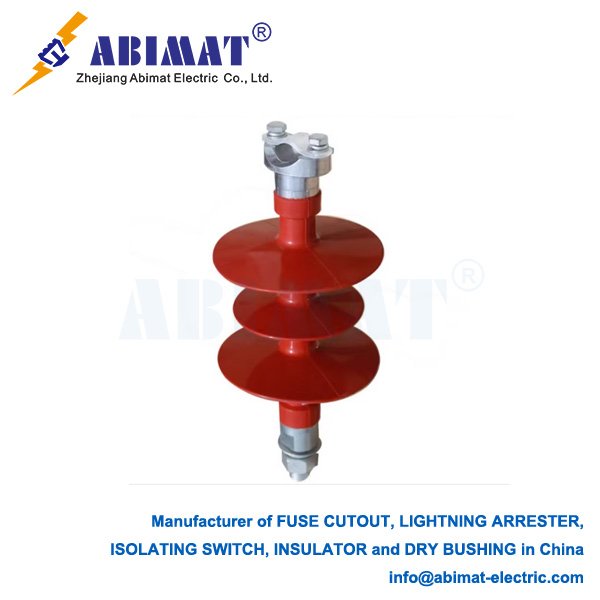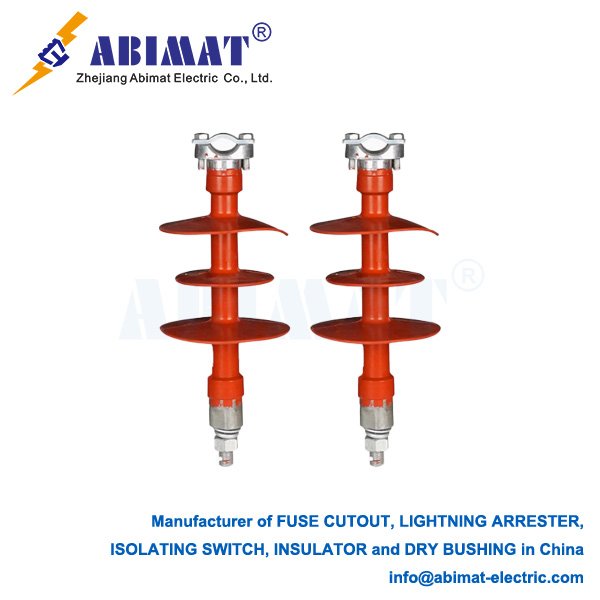33 kV Composite Pin Insulators: Technical Overview
Design & Construction
33 kV composite pin insulators have three main parts. One part is the fiberglass-reinforced epoxy (FRP) core. It gives the insulator its mechanical strength. It can handle a minimum cantilever force of 12 kN, as set by IEC 61952. The core is a pultruded rod, with fibers running straight along its length—this helps it carry loads best.
Another part is the high-track silicone rubber housing. It is made of high-temperature vulcanized (HTV) silicone rubber. The sheds on it have a creepage distance of at least 31 mm per kV. This meets Class IV pollution standards from IEC 60815. It also has aluminum trihydrate (ATH) mixed in, which makes it better at resisting arcs.
The third part is the metal fittings. They are made of hot-dip galvanized steel or ductile iron. They are attached using compression crimping, which ensures they grip the core completely. The base has an M24 thread, following ANSI C29.9 standards.

Key Performance Advantages
Composite insulators weigh 1.8–2.5 kg. Porcelain ones are heavier, 8–12 kg. This makes composite insulators 75% easier to install.
Composite insulators can handle a cantilever strength of at least 12 kN. Porcelain ones max out at 8 kN. So composite types are stronger mechanically.
When it comes to pollution, composite insulators meet Class IV standards. Porcelain ones only reach Class III. This means composite insulators work better in coastal areas.
Composite insulators don’t shatter when hit. Porcelain ones are brittle and break easily. This makes composite types better at standing up to vandalism.
Silicone rubber, the material on composite insulators, has a useful trait. It can pass its water-repellent quality to dirt that builds up. Even in salty conditions, this keeps leakage current below 10 mA. This is checked in the IEC 60507 salt-fog test.
Composite insulators also handle earthquakes well. They have an elastic modulus of 40–50 GPa. This lets them take 0.5g seismic shaking without getting damaged.
They hold up well in sunlight too. The material used has no carbon black. After 5,000 hours of UV exposure—tested under ASTM G154—they still keep over 70% of their tensile strength.
Electrical Performance
Dry arcing distance is 330–380 mm.
They can withstand 70 kV for 1 minute at power frequency, as per IEC 60383.
They handle lightning impulses up to 170 kV BIL—this is tested with 10 positive and negative impulses.
Partial discharge is less than 5 pC at 1.2 times the rated voltage.
Manufacturing & Testing
During production, the FRP rod first gets surface treatment—sandblasting and a primer. Then, HTV silicone is injection molded. Next, end fittings are attached with compression crimping. Finally, the δ-angle is checked to make sure it deviates by no more than 1°.
There are mandatory tests. For mechanical strength, they must handle 125% of the specified mechanical load for 1 minute. For the environment, they undergo 1,000 hours of salt mist and UV aging. For electrical performance, they pass a wet power frequency test at 50 kV. For the interface seal, they are immersed in water for 42 days, with weight gain kept below 0.05%.
Applications & Installation
They meet IEC 61952, which covers insulators for overhead lines. They also fit IEC 62217, the standard for polymeric high-voltage insulators. They comply with ANSI C29.11/12 for composite distribution insulators and AS 3607, the Australian standard for composite insulators.
Failure Modes & Mitigation
Core brittle fracture is prevented by ISO 9001-certified sealing processes. Shed erosion is limited to less than 2 mm deep after 1,000 kJ/kV energy stress. For vandalism, bird deterrents are used in areas with birds. For corrosion, coastal installations use zinc-thickened galvanizing (over 85 μm).
Standards Compliance
They meet IEC 61952, which covers insulators for overhead lines. They also fit IEC 62217, the standard for polymeric high-voltage insulators. They comply with ANSI C29.11/12 for composite distribution insulators and AS 3607, the Australian standard for composite insulators.
Conclusion
Abimat 33 kV composite pin insulators work better than traditional porcelain ones in terms of performance and weight. They don’t break easily, which makes the power grid more reliable. Their standardized designs work with systems worldwide. Choosing them according to IEC/ANSI standards and checking them yearly with infrared (looking for temperature differences over 8°C) helps them last over 30 years, even in tough environments.


